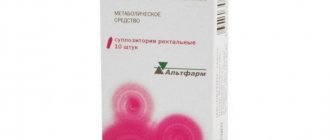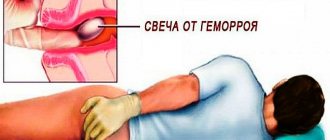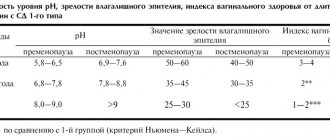Compound
Since there are several main forms of this drug (injection solution, rectal suppositories), the composition of the drug may vary.
One Pyrogenal suppository, depending on the dosage, may contain 50, 100, 150 or 200 mcg. active bacterial type lipopolysaccharide , as well as auxiliary compounds such as purified water, lanolin and cocoa butter.
In 1 ml. a solution intended for injection may contain 10, 25, 50 or 100 mg. active substance, as well as an auxiliary compound such as phosphate buffer solution , pH, which is in the range of 6.7-7.3.
Pyrogenal
Last modified date: 19.05.2015
Dosage form: Solution for intramuscular administration
Compound:
Active substance: Bacterial lipopolysaccharide 10, 25, 50, 100 mcg.
Excipients: Phosphate-buffered saline solution (pH 6.7–7.3).
Description of dosage form: Colorless transparent liquid.
Characteristics: Pyrogenal is a lipopolysaccharide isolated from microbial cells of Salmonella typhi.
Pharmacological group: MIBP - cytokine
Pharmacological (immunobiological) properties:
Pyrogenal is a highly active nonspecific immunomodulator with a broad spectrum of action. Pyrogenal causes a whole complex of complex immunological and physiological changes in the body, the main of which are the activation of the reticuloendothelial, hypothalamic-pituitary and fibrinolytic systems.
Pyrogenal has adjuvant, desensitizing and anti-inflammatory properties, increases the general and specific resistance of the body, and affects the thermoregulatory centers of the hypothalamus.
Pyrogenal activates macrophages, enhances phagocytosis, stimulates the production of interleukin-1 (IL-1), which causes proliferation of a number of body cells (fibroblasts, endothelial cells, hematopoietic cells, etc.), interleukin-2 (IL-2), necessary to maintain growth lymphocytes (primarily T cells), tumor necrosis factor (TNF), induction of endogenous interferon (IF), production of reactive oxygen species. An increase in the functional activity of phagocytes leads to an increase in the body's antimicrobial resistance and accelerated antibody formation.
Thus, due to the activation of macrophage-monocyte cells and the cytokines they secrete, the functional activity of both the cellular and humoral immune response increases.
In connective tissue, under the influence of pyrogenal, the process of development of fibroblasts and the formation of collagen fibers is suppressed, which leads to rejuvenation of the cellular composition of loose connective tissue, and in nervous tissue - to inhibition of the formation of glial scars. Prevents the formation of new ones and resolves previously formed dense scars and adhesions in places of damage, prevents vascular obliteration, stimulates tissue regeneration and epithelization.
Stimulates the activity of hyaluronidase, improves the fibrinolytic properties of blood, increases the activity of lysosomal enzymes, stimulates the kinin system, increases tissue permeability and accelerates the penetration of drugs into the lesion. Promotes the process of resorption of foci of inflammation and restoration of blood circulation.
Activates the function of the pituitary gland - adrenal cortex system, increases the concentration of hormones in the blood, has an anti-inflammatory and analgesic effect. Acts on the thermoregulation center, creating a controlled pyrogenic effect.
Pharmacokinetics:
When pyrogenal is introduced into the body, 85–90% of lipopolysaccharide is fixed on the surface of circulating leukocytes, about 10% remains in the circulating plasma and about 5% is adsorbed on the membranes of erythrocytes.
After administration of the drug, leukopenia develops in the latent period (45–90 min), which is replaced by leukocytosis, which lasts for 24–48 hours. Excreted from the body with urine.
Indications:
The wide range of therapeutic and prophylactic effects of pyrogenal determines the effectiveness of its use as a nonspecific agent in the treatment of various diseases in surgery, neurosurgical, urological, gynecological, dermatovenerological, therapeutic, psychiatric practice, ophthalmology, pediatrics, narcology, etc.
The drug is intended for nonspecific therapy: in surgical practice (adhesive disease, post-burn keloid scars and contractures, trauma, vascular diseases, prevention of vascular obliteration, etc.); traumatic injuries of the central and peripheral nervous system, spina bifida, cerebral arachnoiditis; torpid - current form of tuberculosis in the resorption phase; chronic liver diseases; strictures of the urethra and ureters, chronic prostatitis and urethritis; severe eye burns, uveitis, iridocyclitis, herpes virus infection of the eyes, corneal opacities, optic and auditory neuralgia, viral keratitis and conjunctivitis; inflammatory processes of the uterine appendages, infertility; adhesive disease of the abdominal cavity; sexually transmitted diseases, psoriasis and other chronic skin diseases; as well as in cases of increased resistance of microorganisms to chemotherapy and antibiotic therapy.
As a pyrogenic drug, it is used in cases of indication for pyrotherapy (dermatovenereology, narcology, psychiatry).
Contraindications:
Acute febrile illnesses; Chronic diseases in the stage of exacerbation and decompensation, with the exception of diseases that are an indication for the use of pyrogenal; Blood diseases; Pregnancy and lactation period. For people suffering from chronic diseases of the cardiovascular system, kidneys and diabetes, treatment should be carried out under the supervision of a doctor.
In the presence of convulsive readiness or a history of febrile convulsions, the drug is either not prescribed or is administered against the background of anticonvulsant therapy.
Directions for use and dosage:
Pyrogenal, a solution for intramuscular administration, is used intramuscularly once a day. Injections are given every other day. If necessary, dilute with 0.9% sodium chloride solution for injection. The drug cannot be stored in an opened ampoule.
Therapeutic doses of pyrogenal are individual.
The initial single dose for adults is 2.5 mcg. On subsequent days of injection, the dose is gradually increased by 2.5–5.0 mcg. The maximum single dose is 100 mcg. The course of treatment is from 10 to 30 injections depending on the disease.
The initial single dose for children is 0.5–1.5 mcg. On subsequent days of injection, the dose is gradually increased by 0.5–1.5 mcg or 2.5 mcg, depending on the age of the children. The maximum single dose is 25–30 mcg. The course of treatment is from 10 to 15 injections depending on the disease.
If necessary, courses of injections are repeated after 2–3 months.
When prescribing pyrogenal for the purpose of pyrotherapy, the drug is administered intramuscularly once a day, starting with 5–10 mcg, with a gradual increase in the dose to 100–150 mcg. Injections are carried out after one or two days as prescribed by the doctor.
Side effects:
When the drug is administered, usually no reactions occur. In some patients, the temperature may rise to 37.5 °C, accompanied by mild chills and mild malaise. This condition can last from 3 to 8 hours. In this case, the dose that caused such a reaction is repeated in subsequent days until the reaction to its administration ceases (usually 1-3 injections), after which the dose is successively increased.
In rare cases, individuals may experience severe chills, fever up to 39.5 ° C, headache, and lower back pain. These reactions usually last from 6 to 8 hours, after which the temperature drops and the side effects disappear. In these cases, it is recommended to reduce the dose of the drug.
When using the drug for pyrotherapy, the above reactions are acceptable.
Interaction:
The drug is compatible and goes well with all medications used in the treatment of these diseases. Enhances the effectiveness of specific chemotherapeutic drugs in complex therapy.
Special instructions:
For children under 5 years of age and persons over 60 years of age, the drug should be prescribed in reduced doses and increased only if the drug is well tolerated under medical supervision.
Release form:
Ampules contain 1 ml of pyrogenal solution containing 10, 25, 50, 100 mcg of lipopolysaccharide.
The package contains 10 ampoules of one concentration along with instructions for use. When using ampoules without a ring or break point, an ampoule knife is additionally inserted.
Storage conditions: In accordance with SP 3.3.2.1248–03, in a place protected from light, out of reach of children at a temperature of 2 to 10 °C.
Transportation: In accordance with SP 3.3.2.1248–03, at temperatures from 2 to 20°C.
Shelf life: 2 years.
A drug that has expired cannot be used.
Conditions for dispensing from pharmacies: By prescription.
Release form
Suppositories, distinguished by white or yellowish color, with a diameter of 10 mm. with a pointed end of a cylindrical shape and uniform consistency, produced in specialized packaging (contour cells) in a set of 3 pieces. dosage of 50 mg, 3 pcs. – 100 mg each, 3 pcs. - 150 mg each, as well as 3 pcs. – 200 mg. As a result, one cardboard package of Pyrogenal contains a set of candles (12 pcs.).
The solution intended for injection is packaged in special ampoules. One cardboard package of the medicine contains 10 ampoules of 1 ml each. solution in each.
Pharmacodynamics and pharmacokinetics
This drug belongs to immunomodulators , which have a wide spectrum of action. The compounds included in Pyrogenal affect the hypothalamus, the adrenal cortex, and the pituitary gland. In addition, the drug affects the fibrinolytic as well as the reticuloendothelial system.
LPS increases the level of corticosteroids in the blood , and also affects the functioning of the adrenal cortex , increases resistance and changes the thermoregulatory centers of the hypothalamus , thereby creating a pyrogenic effect that can be controlled. The drug interacts with the phagocytic system, thus triggering the synthesis of IL-2 , as well as IL-1 , the secretion of oxygen radicals and IFN (interferon) .
Pyrogenal is involved in stimulating the body's kinin system , prevents the synthesis of collagen by fibroblasts and accelerates the maturation of fibrocytes . By stimulating hyaluronidosis , as well as reducing the production of collagen fibers , this medicine increases tissue permeability, ultimately improving the fibrinolytic properties of the blood , and increasing the rate of distribution of active compounds in the body.
The drug helps speed up the process of resorption of previously formed scars in the lesions, and also prevents the process of formation of adhesions . In addition, the medicinal compound has regenerative properties and helps in restoring lost body functions to the wound.
Pyrogenal in complex therapy of chronic bacterial prostatitis
Chronic prostatitis is the most common urological condition in men under 50 years of age, accounting for 8% of outpatient visits to a urologist (2). With age, the incidence of the disease increases and reaches 30-73% (3). Chronic bacterial prostatitis (CKD) accounts for 5-15% of cases (4).
The most common etiological agents of CKD are members of the family of gram-negative bacteria Enterobacteriaceae
, which enter the prostate gland from the gastrointestinal tract.
The most common strains are Escherichia coli
, which are found in 65-80% of infections.
Pseudomonas aeruginosa
,
Serratia
.,
Klebsiella
. and
Enterobacter aerogenes
, and
Acinetobacter
spp.
are detected in the remaining 10-15% (5). Enterococci account for 5 to 10% of confirmed prostate infections (6). The role of Gram-positive bacteria such as Staphylococcus
and
Streptococcus
in CKD is controversial (6).
A number of researchers believe that these microorganisms are not a common cause of prostate infection, others have suggested the etiological role of such gram-positive organisms as Staphylococcus saprophyticus
, hemolytic staphylococci,
Staphylococcus aureus
and other coagulase-negative staphylococci.
Risk factors that contribute to the colonization of the prostate gland (PG) by bacteria or the occurrence of infection caused by opportunistic bacteria include: intraprostatic reflux of urine into the ducts; phimosis; anal-genital intercourse without protection; urinary tract infection; acute epididymitis; indwelling urethral catheters and transurethral surgery in men with infected urine without prior antimicrobial therapy (1).
A separate link in the development of chronic prostatitis is a sexually transmitted infection (STI), such as trichomoniasis. According to WHO, trichomoniasis affects about 10% of the world's population. The cause of inflammatory processes in men in 23-40% is trichomonas infection (7). Treatment of trichomonas prostatitis is significantly complicated due to the emergence of strains resistant to metronidazole, low concentrations of the drug in areas of spread of the pathogen, side effects of protistocides and frequent co-infections. All this forces us to look for new drugs and routes of their administration that provide targeted transport to target cells.
For the purpose of nonspecific immunostimulation, namely activation of phagocytic reactions, increased blood flow and resorption of infiltrate in foci of chronic inflammation, we used the drug Pyrogenal® in the form of rectal suppositories.
The purpose of this work is to study the effectiveness and safety of the drug Pyrogenal in the form of rectal suppositories in patients with CKD.
Materials and methods
The study included 23 patients diagnosed with CKD. The average age of the patients was 30.6 years (from 24 to 45 years), the duration of the disease was from 3 months to 5 years. All patients underwent a physical examination, digital rectal examination, laboratory tests (clinical blood and urine tests, microscopy of pancreatic secretions), as well as bacteriological examination in the form of a 4-glass Meares-Stamey localization test with determination of the sensitivity of the isolated microflora to antibiotics, and TRUS of the pancreas. CKD symptoms were assessed using the US National Institutes of Health Chronic Prostatitis Symptom Scale. And also to identify STIs, scrapings from the urethra and pancreatic secretions were examined for atypical intracellular microorganisms using the polymerase chain reaction (PCR).
The disease manifested itself as pain in the pelvic region in all patients (the average pain symptom score was 12.2), and urinary disorders in 13 patients (the average score was 3.4). The average score for assessing quality of life was 6.8. According to microscopic examination of pancreatic secretions, an increase in the number of leukocytes (more than 10 per field of view) and a decrease in the number of lecithin grains were noted in 13 patients. Moreover, in 3 patients, leukocytes covered all fields of view, and in the remaining 10 patients, the number of leukocytes was 10-30 per field of view; in 7 patients – 10-15, in 3 patients – 20-30. STIs were also detected in 15 of 23 patients; 7 had trichomoniasis, 4 had ureaplasmosis, 2 had chlamydia, 2 had trichomoniasis in combination with chlamydia. Transrectal ultrasound examination revealed an increase in prostate volume (mean volume was 32.6 cm3) along with focal and diffuse hyperechogenicity in the prostate tissue.
Pyrogenal® rectal suppositories were prescribed to 20 patients, 100 mcg (2 rectal suppositories) once on the first day, and on subsequent days, 200 mcg (2 rectal suppositories, 100 mcg each) per day. The course of treatment was two weeks. As etiotropic therapy, from the 3rd day of treatment, a combination of antibacterial and anti-inflammatory therapy was used, depending on the causative agents of CKD. Three patients made up the control group, who received etiotropic therapy with antibacterial and anti-inflammatory drugs without the use of the drug Pyrogenal®. Clinical and bacteriological monitoring of the effectiveness of the therapy was carried out after 2 weeks of taking the drug. Particular attention was paid to the presence of side effects.
Results and discussion
After two weeks of treatment, all study patients showed improvement in CKD symptoms, which was expressed in the disappearance or reduction of pain in the pelvic region and normalization of urination. In the group of patients who used Pyrogenal® (20 patients), the most pronounced improvement in symptoms was noted compared to the control group (3 patients). It should be noted that a decrease in pain in patients using Pyrogenal® was noted earlier than in the control group: days 3-5 – in those taking Pyrogenal®, days 7-9 – in the control group. According to the bacteriological study, eradication of pathogens was achieved in 22 (95.6%) patients. It was not possible to achieve eradication in 1 patient, and he was prescribed a 10-day course of repeated antimicrobial therapy with a positive effect.
According to PCR diagnostics, pathogen eradication was achieved in all patients (100%).
During control TRUS, a decrease in prostate volume was noted: the average prostate volume was (25.6 cm3). In general, the drug Pyrogenal® was well tolerated by patients. The slight increase in temperature in 2 of them to a maximum of 37.5°C in the first two days of taking the drug did not cause the need to discontinue Pyrogenal.
Conclusion
Thus, the use of Pyrogenal in the form of rectal suppositories in the complex therapy of CKD has shown high efficiency, which consists in improving symptoms and laboratory parameters due to the ability to increase the local concentration of antibacterial drugs in organs and tissues, as well as directly influence the immune system by increasing the production of interferon, activation hormonal system. This fact proves the ability of Pyrogenal to have an immunomodulatory effect.
The drug Pyrogenal® in the form of rectal suppositories can be recommended for inclusion in the complex therapy of CKD.
Indications for use
Both suppositories and Pyrogenal injection solution are used in the treatment of the following diseases:
- strictures of the ureters as well as the urethra ;
- liver diseases (chronic);
- urethritis;
- prostatitis;
- abdominal diseases;
- in gynecology - sexually transmitted diseases, secondary infertility, inflammatory diseases of the uterine appendages;
- burn diseases.
Rectal suppositories are used to treat human papillomavirus , and the drug is also used as an immunorehabilitation and immunoprophylactic agent during the recovery period of patients after viral and bacterial diseases.
Pyrogenal injection solution is used in the treatment of damage to the nervous system (peripheral, central) caused by trauma , as well as tuberculosis (sluggish form), iridocyclitis , corneal opacities, uveitis, psoriasis, eye infections and as a pyrogenic agent in pyrotherapy.
Often this drug is used during autohemo provocation (i.e., a procedure for transfusion of blood from a vein into the gluteal region). Moreover, Pyrogenal is used for provocation in men as often as for provocation in women.
Side effects
When using Pyrogenal rectal suppositories, body temperature may increase to a maximum of 37.6 C, as well as primary flu symptoms (fatigue, chills, nausea, fever, arthralgia, headaches and myalgia).
When using a medicinal solution for injection, the same side effects may occur, and lower back pain may also occur and body temperature may rise to 39.5 C. It is worth noting that the above side effects of the drug are quite acceptable when used during pyrotherapy .
Pyrogenal, 25 mcg/ml, solution for intramuscular administration, 1 ml, 10 pcs.
Characteristics of drugs.
A mixture of lipopolysaccharide isolated from the bacteria
Salmonella typhi
with a filler.
Pharmaceutical action.
A broad-spectrum immunomodulator that activates the reticuloendothelial, hypothalamic-pituitary and fibrinolytic systems. It has desensitizing and anti-inflammatory properties, increases the general and specific resistance of the body, and affects the thermoregulatory centers of the hypothalamus.
Indications.
Injuries of the central nervous system and peripheral nervous system, tuberculosis (torpid form in the resorption phase), chronic liver diseases, strictures of the urethra, ureters, chronic prostatitis, urethritis, uveitis, iridocyclitis, herpetic eye infection, corneal opacities, inflammation of the uterine appendages, infertility, abdominal adhesive disease cavities, burn disease, sexually transmitted diseases, psoriasis and other chronic skin diseases. For pyrotherapy.
Contraindications.
Acute febrile diseases, chronic diseases in the stage of exacerbation and decompensation (with the exception of diseases that are an indication for the drug), blood diseases, pregnancy.
With caution:
diseases of the cardiovascular system, kidneys, diabetes mellitus, decreased seizure threshold, seizures, febrile seizures.
Dosage regimen.
IM,
1 time per day every other day, if necessary, the drug is diluted with 0.9% NaCl solution.
The initial single dose is 0.2 mcg, in subsequent days the dose is gradually increased by 2.5–5 mcg. The maximum single dose is 100 mcg. The full course is 10–30 injections; if necessary, the course can be repeated after 2–3 months. For pyrotherapy - intramuscularly once a day, starting with 5–10 mcg and increasing the dose to 100–150 mcg. Injections are carried out after 1–2 days. Rectally,
1 sup. per day every day or every other day, initial dose - 50 mcg, maximum dose - 200 mcg. The course of treatment is 12–15 supp. The recommended treatment regimen is: 50, 50, 50, 100, 100, 100, 150, 150, 150, 200, 200, 200 mcg. When using suppositories as monotherapy for immunorehabilitation in case of incomplete recovery after an acute bacterial or viral disease, suppositories of 50 or 100 mcg should be used. The course of treatment is 5–10 supp. Simultaneous treatment with suppositories and intramuscular injections is possible.
Side effects.
Hyperthermia (up to 37.5 °C, chills, malaise; rarely - hyperthermia (up to 39.5 °C), severe chills, headache, lower back pain.
Special instructions.
If, with intramuscular administration, hyperthermia, chills, and malaise usually occur within 3–8 hours, then the dosage that caused such a reaction is repeated in the following days (usually 1–3 days) until the reaction stops, after which the dose is successively increased. If hyperthermia up to 39.5 °C, severe chills, headache, and lower back pain occur within 6–8 hours, it is recommended to reduce the dose of the drug. When using the drug for pyrotherapy, the above reactions are acceptable. In the presence of convulsive readiness, the drug is prescribed against the background of anticonvulsant therapy.
Pyrogenal injections, instructions for use (Method and dosage)
Intramuscular injections of Pyrogenal are given every other day, one injection per day. To prepare a medicinal solution, the drug is mixed with sodium chloride. The course of therapeutic treatment begins with a dose of 2.5 mg, and then gradually increases every day by a maximum of 5 mg. The maximum permitted single dosage of the drug does not exceed 100 mg.
As a rule, the course of treatment is limited to 10-30 injections. Injections begin to be used again after at least two months have passed since the previous course of treatment. This form of the drug is used in pyrotherapy in a dosage of 10-25 mg. with a gradual increase to 150 mgk. Usually injections are given after 1 or 2 days.
According to the instructions for Pyrogenal suppositories, use one suppository per day rectally at a dosage of 50 mcg. The maximum dosage of the drug is 200 mg. per day. Patients are recommended to use the following drug treatment regimen - suppositories are administered rectally three times a day in a dosage of 50, 100, 150 or 120 mg.
As a rule, approximately 12 Pyrogenal suppositories are consumed for one course of treatment. Suppositories are often used for immunorehabilitation , as well as immunoprophylactic treatment during the recovery period after acute viral and bacterial diseases in a dosage of 50 or 100 mg. Typically, the course of such treatment is limited to a maximum of 10 suppositories.
Pyrogenal suppositories and injections can be combined.
Pyrogenal, 50 mcg, rectal suppositories, 10 pcs.
Characteristics of drugs.
A mixture of lipopolysaccharide isolated from the bacteria
Salmonella typhi
with a filler.
Pharmaceutical action.
A broad-spectrum immunomodulator that activates the reticuloendothelial, hypothalamic-pituitary and fibrinolytic systems. It has desensitizing and anti-inflammatory properties, increases the general and specific resistance of the body, and affects the thermoregulatory centers of the hypothalamus.
Indications.
Injuries of the central nervous system and peripheral nervous system, tuberculosis (torpid form in the resorption phase), chronic liver diseases, strictures of the urethra, ureters, chronic prostatitis, urethritis, uveitis, iridocyclitis, herpetic eye infection, corneal opacities, inflammation of the uterine appendages, infertility, abdominal adhesive disease cavities, burn disease, sexually transmitted diseases, psoriasis and other chronic skin diseases. For pyrotherapy.
Contraindications.
Acute febrile diseases, chronic diseases in the stage of exacerbation and decompensation (with the exception of diseases that are an indication for the drug), blood diseases, pregnancy.
With caution:
diseases of the cardiovascular system, kidneys, diabetes mellitus, decreased seizure threshold, seizures, febrile seizures.
Dosage regimen.
IM,
1 time per day every other day, if necessary, the drug is diluted with 0.9% NaCl solution.
The initial single dose is 0.2 mcg, in subsequent days the dose is gradually increased by 2.5–5 mcg. The maximum single dose is 100 mcg. The full course is 10–30 injections; if necessary, the course can be repeated after 2–3 months. For pyrotherapy - intramuscularly once a day, starting with 5–10 mcg and increasing the dose to 100–150 mcg. Injections are carried out after 1–2 days. Rectally,
1 sup. per day every day or every other day, initial dose - 50 mcg, maximum dose - 200 mcg. The course of treatment is 12–15 supp. The recommended treatment regimen is: 50, 50, 50, 100, 100, 100, 150, 150, 150, 200, 200, 200 mcg. When using suppositories as monotherapy for immunorehabilitation in case of incomplete recovery after an acute bacterial or viral disease, suppositories of 50 or 100 mcg should be used. The course of treatment is 5–10 supp. Simultaneous treatment with suppositories and intramuscular injections is possible.
Side effects.
Hyperthermia (up to 37.5 °C, chills, malaise; rarely - hyperthermia (up to 39.5 °C), severe chills, headache, lower back pain.
Special instructions.
If, with intramuscular administration, hyperthermia, chills, and malaise usually occur within 3–8 hours, then the dosage that caused such a reaction is repeated in the following days (usually 1–3 days) until the reaction stops, after which the dose is successively increased. If hyperthermia up to 39.5 °C, severe chills, headache, and lower back pain occur within 6–8 hours, it is recommended to reduce the dose of the drug. When using the drug for pyrotherapy, the above reactions are acceptable. In the presence of convulsive readiness, the drug is prescribed against the background of anticonvulsant therapy.
Analogs
Level 4 ATX code matches:
Estifan
Septilin
Sodium nucleinate
Gepon
Imudon
Immunal
Wobenzym
Respibron
Ruzam
Phlogenzyme
Glutoxim
Histamine dihydrochloride
Timalin
Cycloferon
Uro-Vaxom
Engystol
Imunofan
Imunorix
Kipferon
Tsitovir-3
There are currently no structural analogues of Pyrogenal.
Pyrogenal price, where to buy
You can buy Pyrogenal suppositories and injection solution freely in many pharmacies. The cost of the drug depends on the form of release and the region. For example, the average price of Pyrogenal in ampoules varies from 350 to 500 rubles, and rectal suppositories - from 570 to 800 rubles.
- Online pharmacies in RussiaRussia
- Online pharmacies in KazakhstanKazakhstan
ZdravCity
- Pyrogenal rectal suppositories set 12 pcs.
(50/100/150/200 mg for 3) NIIEM im. N.F. Gamaleya 2255 rub. order - Pyrogenal solution for injection 100 µg/ml 1 ml 10 pcs. NIIEM im. N.F. Gamaleya
RUB 1,557 order
- Pyrogenal solution for in. 50 µg/ml 1 ml 10 pcs. NIIEM im. N.F. Gamaleya
RUB 1,471 order
- Pyrogenal solution for intramuscular injection. amp. 25mcg/ml 1ml No. 10NIIEM im. N.F. Gamaleya
RUB 1,275 order
- Pyrogenal solution for intramuscular injection. amp. 10mcg/ml 1ml No. 10NIIEM im. N.F. Gamaleya
1201 rub. order
Pharmacy Dialogue
- Pyrogenal (amp. 100 µg 1 ml No. 10) Medgamal
RUB 1,496 order
show more





